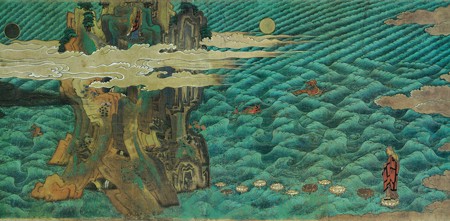The scroll relates the biography of the great Chinese pilgrim Xuanzang (d. 664) and his epic seventeen-year pilgrimage from China to India. He returned to China with hundreds of Buddhist texts in the original Sanskrit. These he translated into Chinese, thereby changing the course of Buddhist history in East Asia. Cycles of increasingly imaginative stories about Xuanzang circulated throughout the East Asian cultural macrosphere, culminating in the publication of the Ming dynasty novel Journey to the West (Xiyouji). As a fourteenth-century Japanese iteration of what was originally a Chinese story, the handscroll, now a designated National Treasure, constitutes another species of translation: that of Xuanzang’s life story, as it is preserved within the sacrosanct textual confines of the Buddhist Tripitaka, into a carefully abridged illustrated handscroll, or emaki.
The production of magnificent
My dissertation, completed this year at CASVA, presents a case study for the interrogation of the composition and function of illustrated sacred biography in East Asia. Reading the scroll texts and paintings in concert against a constellation of self-indicated lexical and pictorial sources revealed that the source of the scroll’s efficacy as a numinous object lies in an exquisitely choreographed analogical mode of explicitly intertextual composition. The sophisticated discursive editorial policy that guided its composition produced a self- canonizing object that manipulates the unique expressive plasticity of the
The demands and rewards of the scroll itself governed the choice of close reading as my primary methodological tool, which in turn uncovered a pervasive self-reflexivity in the scroll paintings. Their deep imbrication with the textual portions of the scroll renders the scroll legible as both icon and relic, with the capacity to imaginatively transpose the mundane present and cosmic past. Importantly, these close readings also led to the resolution of a seventy-year-old Japanese scholarly debate over whether the scroll constitutes a unique work or represents a copy of an older, now lost, original. From identification of the scroll’s graphic inscription of narrative and subnarrative, numerous double portraits, and eschatologically driven chronotopic transpositions of ancient Indian sites to contemporary locations in Japan, it became clear that, as much as the scroll depicts “India,” it was also simultaneously intended to depict, and spiritually activate, the very landscape in which it remained sequestered for so many centuries.
